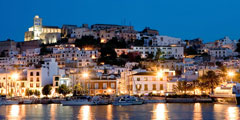Naples
The first reference to Naples, Neapolis to the Greeks, is found in the Homeric legend of the sirens.
In Roman times the city itself was considered a relaxed place of high culture. When Vesuvius erupted in 79 AD, Neapolis escaped the fates of Pompeii and Herculaneum' thanks to a prevailing southwest wind.
Today, Naples is the third largest city in Italy and a sprawling one, with a centre that has many different focuses.
The area between Piazza Garibaldi and Via Toledo, roughly corresponding to the Roman Neapolis (much of which is still unexcavated below the ground), makes up the old part of the city, the centro storico, and the main streets still following the path of the old Roman roads.
The main Via Toledo stretches from Palazzo Reale up to the Archeological Museum and the heaths of Capodimonte. Many of the city's museums are located in the elegant hilltop district of Vomero and in Chiaia, behind which lies the long green boulevard of Villa Comunale.
Things to see
Museo Archeologico Nazionale
Home to the Farnese Collection of antiques from Lazio and Campania, Naples Museo Archeologico Nazionale also houses the best of the finds from nearby Pompeii and Herculaneum.
The ground floor of the museum concentrates on sculpture from the Farnese Collection, including the Farnese Bull and Farnese Hercules from the Baths of Caracalla in Rome. The mezzanine floor houses the museum's collection of Roman mosaics, which give a superb insight into everyday life.
Upstairs there is an assortment of Roman statues, wall paintings and mosaics from the villas in Pompeii and Herculaneum.
Piazza Municipio, Piazza Plebiscito and Palazzo Reale
Piazza Municipio is a busy traffic junction that stretches from the ferry terminal to the Palazzo Municipale (Town Hall) and dominated by the 'Maschio Angioino - erected in 1282 by the Angevins and later converted as the royal residence of the Aragon monarchs.
Just beyond the castle, on the left, the Teatro San Carlo is a building which is unimpressive from the outside, inside however, you can see why this theatre was the envy of Europe when it opened in 1737 in time for the birthday of Charles of Bourbon, for whom it was built. It's still the largest opera house in Italy and one of the most distinguished in the world.
Piazza Plebiscito is characterized by a curved colonnade modeled on the piazza designed by Bernini for Saint Peter's in Rome. The Church of Francesco di Paola, inspired by Rome's Pantheon, is at its most impressive at night, when it is lit by footlights.
Palazzo Reale was built between 1600 and 1602 by Domenico Fontana for Philip II. Today the building houses a museum and National Library.
Chiostro di Santa Chiara
The Cloister of Santa Chiara is an unexpected oasis of peace in the heart of old Naples. The walls, benches and octagonal columns are decorated with brightly colored land and seascapes depicted on majolica tiles. The Rococo architect Domenico Vaccaro completed these unusual cloisters in 1742.
Palazzo Reale di Capodimonte
Now home to the picture gallery of Naples' Museo Nazionale di Capodimonte, the Royal Palace of Capodimonte was built as the royal residence of the Bourbon King Charles III in 1738.
The royal apartments on the first floor may be smaller and less sumptuous than those in the Royal Palace of Caserta, but in many ways are much more enjoyable; not least because you can actually walk through the rooms freely.
Upstairs, the picture gallery holds a superb collection of Renaissance paintings.
